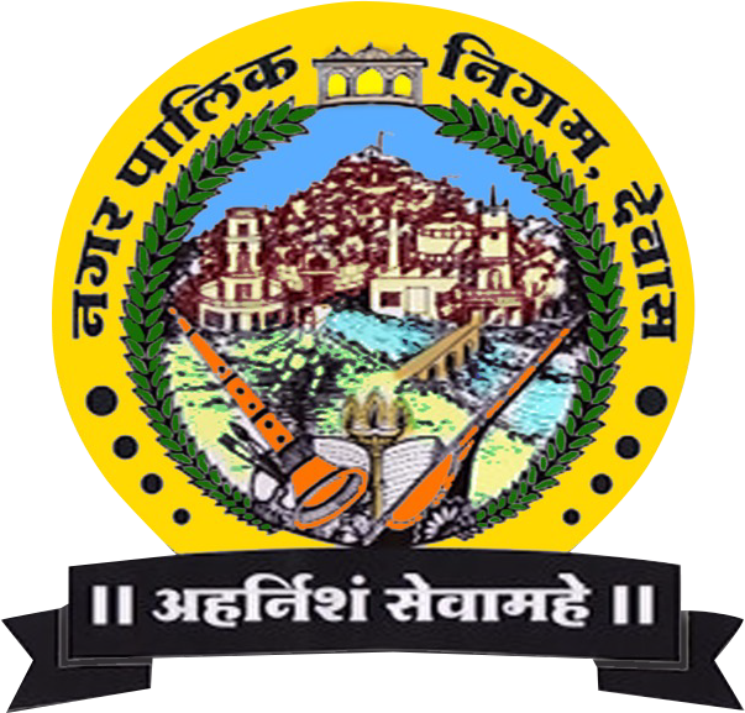The name Dewas is derived from the Devi Vaishini hill in the city, commonly known as Tekri. The hill has a temple of deity Devi Tulja Bhawani, Chamunda Mata and Kalika Mata. The word Dewas is also believed to be a sandhi of words Dev deity and Vas Marathi for abode, thus Dewas means abode of the deity or god. Swami Shivom Tirtha wrote the History of the hill (Tekri)of Dewas in his book—Sadhan Shikhar. E.M.Forster wrote a Travelogue named -The Hill of Devi in 1953.The Hill of Devi is his non-fictional account of him.
The district gets its name from the district headquarters town, Dewas which is said to have been derived on the basis of two traditions. One is that Dewas lies on the foot of a conical hill, known as Chamunda hill about 300 ft. above the ground level on top of which the shrine of Chamunda is located. The image of the Goddess is cut in rocky wall of a cave. It is, therefore, known as Devi Vashini or the Goddess’s residence. From this the name Dewas (dev-vas) seems to have been derived. The other view of the probable origin is from the name of the founder of the village Dewasa Bania.
The present Dewas district broadly corresponds to the twin treaty States in Malwa Political charge of the Central India Agency, divided into a Senior and a Junior branch of the early twentieth century with some adjustments of other territories. There were two district chief ships with separate administrations, acting independently in most matters, sharing the same capital town of Dewas. Consequent upon the merger of princely States and the formation of Madhya Bharat State in 1948 there was reconstitution of boundaries and thus the district in the present form was constituted. The reconstituted district was, however, formed by merging 242 villages of the two tahsils of Dewas of the former Senior and Junior State, 452 villages of Sonkatch tahsil and of 99 villages of Ujjain tahsil of former Gwalior state, 99 villages of Nimanpur tahsil of former Dhar state, one village of Jawar tahsil of former Bhopal State, and then the existing tahsils of Kannod and Khategaon of former Holkar State. With the reorganization of States on linguistic basis on 1stNovember 1956, Madhya Bharat, with other territories got merged to form the New state of Madhya Pradesh and thus Dewas continues to be one of the districts in it.
The district is now divided into 9 tehsils viz. Sonkatch, Dewas, Bagli, Kannod, Tonk-Khurd, Khategaon, Satwas, Hatpipliya and Udainagar. Dewas tehsil is situated on the north-western part of the district, Sonkatch on the north-eastern part, Bagli on the south, Kannod on the south-central part and Khategaon on the South-east. Weather road connects all the tahsil head quarters. The Head-quarters of Dewas tehsil, which is also the district headquarters, is situated on The Bombay-Agra National Highway No.3 and is also connected by broad-gauge railway line of western Railway.
Geography
Dewas lies northeast of Indore, southeast of Ujjain, and southwest of Shajapur. The city is located on the level plains of the Malwa plateau; to the south, the land rises gently to the Vindhya Range, which is the source of the Chambal and Kali Sindh rivers that flow north through the district on their way to the Ganges. The main river in Dewas is Kshipra.
Demographic
As of 2011 Indian Census, Dewas had a total population of 289,550, of which 150,081 were males and 139,469 were females. Population within the age group of 0 to 6 years was 35,437. The total number of literates in Dewas was 215,088, which constituted 74.3% of the population with male literacy of 79.9% and female literacy of 68.3%. The effective literacy rate of 7+ population of Dewas was 84.6%, of which male literacy rate was 91.1% and female literacy rate was 77.7%. The Scheduled Castes and Scheduled Tribes population was 56,366 and 9,861 respectively. Dewas had 57397 households in 2011.
Industry
Dewas was known for being a production centre of retail opium in the 1800s, as noted in the 1895 first report of the Royal Commission on Opium.Rapid industrialisation took place in the late 1970s and early 1980s, but due to inadequate infrastructure, the pace has slowed since the late 1980s. In recent years, some industries have closed their operations due to a shortage of sufficient infrastructure to support growth; there is a shortage of water due to excessive usage in previous decades.
The city has many industrial units providing employment to thousands of workers. The largest companies include Tata, Kirloskar and John Deere. Dewas is known as the soy capital of India and is a major part of the soy bean processing industry in the country.
Due to its location above sea level at one corner of the Malwa plateau, constant wind flows in the region are suitable for harvesting wind energy. There are more than 100 wind mills on a hill 13 km (8.1 mi) from Dewas, generating around 15 megawatts of power. These were financed by a few private companies which sought a reliable power supply.
